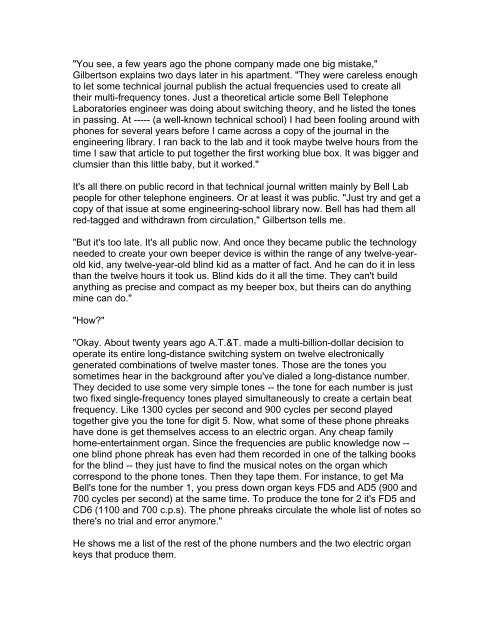The Official Phreaker's Manual - Shadow Spy - Free
The Official Phreaker's Manual - Shadow Spy - Free
The Official Phreaker's Manual - Shadow Spy - Free
You also want an ePaper? Increase the reach of your titles
YUMPU automatically turns print PDFs into web optimized ePapers that Google loves.
"You see, a few years ago the phone company made one big mistake,"<br />
Gilbertson explains two days later in his apartment. "<strong>The</strong>y were careless enough<br />
to let some technical journal publish the actual frequencies used to create all<br />
their multi-frequency tones. Just a theoretical article some Bell Telephone<br />
Laboratories engineer was doing about switching theory, and he listed the tones<br />
in passing. At ----- (a well-known technical school) I had been fooling around with<br />
phones for several years before I came across a copy of the journal in the<br />
engineering library. I ran back to the lab and it took maybe twelve hours from the<br />
time I saw that article to put together the first working blue box. It was bigger and<br />
clumsier than this little baby, but it worked."<br />
It's all there on public record in that technical journal written mainly by Bell Lab<br />
people for other telephone engineers. Or at least it was public. "Just try and get a<br />
copy of that issue at some engineering-school library now. Bell has had them all<br />
red-tagged and withdrawn from circulation," Gilbertson tells me.<br />
"But it's too late. It's all public now. And once they became public the technology<br />
needed to create your own beeper device is within the range of any twelve-yearold<br />
kid, any twelve-year-old blind kid as a matter of fact. And he can do it in less<br />
than the twelve hours it took us. Blind kids do it all the time. <strong>The</strong>y can't build<br />
anything as precise and compact as my beeper box, but theirs can do anything<br />
mine can do."<br />
"How?"<br />
"Okay. About twenty years ago A.T.&T. made a multi-billion-dollar decision to<br />
operate its entire long-distance switching system on twelve electronically<br />
generated combinations of twelve master tones. Those are the tones you<br />
sometimes hear in the background after you've dialed a long-distance number.<br />
<strong>The</strong>y decided to use some very simple tones -- the tone for each number is just<br />
two fixed single-frequency tones played simultaneously to create a certain beat<br />
frequency. Like 1300 cycles per second and 900 cycles per second played<br />
together give you the tone for digit 5. Now, what some of these phone phreaks<br />
have done is get themselves access to an electric organ. Any cheap family<br />
home-entertainment organ. Since the frequencies are public knowledge now -one<br />
blind phone phreak has even had them recorded in one of the talking books<br />
for the blind -- they just have to find the musical notes on the organ which<br />
correspond to the phone tones. <strong>The</strong>n they tape them. For instance, to get Ma<br />
Bell's tone for the number 1, you press down organ keys FD5 and AD5 (900 and<br />
700 cycles per second) at the same time. To produce the tone for 2 it's FD5 and<br />
CD6 (1100 and 700 c.p.s). <strong>The</strong> phone phreaks circulate the whole list of notes so<br />
there's no trial and error anymore."<br />
He shows me a list of the rest of the phone numbers and the two electric organ<br />
keys that produce them.


